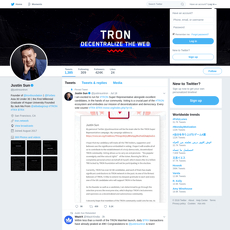Alex Gladstein Review
Alex Gladstein
x.com
Alex Gladstein Review Guide: Everything You Need To Know About + FAQ
Curious whether following @gladstein on X is actually worth your time, or just another rabbit hole of hot takes and endless threads?
If you care about how money, freedom, and technology intersect in the real world—not just on price charts—Alex Gladstein’s feed often lands where policy, human rights, and Bitcoin meet. The trick is figuring out what’s signal, what’s noise, and how to turn his posts into useful insight without getting sucked into debates for hours.
Describe problems or pain
X is a blessing and a headache. You get breaking updates and smart analysis, but also hype, tribal flame wars, and claims that are hard to verify. If you’re trying to understand Bitcoin’s role in places facing capital controls, inflation, or censorship, you’ve probably hit at least one of these walls:
- Too much noise: Viral threads with zero sources, hot takes framed as facts, and engagement farming that buries real research.
- Political crossfire: Complex issues reduced to partisan soundbites that miss on-the-ground realities.
- Hard to fact-check: Claims about sanctions, CBDCs, or adoption with no links, no data, and no local voices.
- Time sink: You want credible sources and context, not a 40-reply argument at 1 a.m.
Meanwhile, the bigger picture matters. For example:
- Financial stress is real: The World Bank’s Global Findex reports that over a billion adults remain unbanked, with many more facing unreliable banking access (World Bank).
- Crypto use skews toward need: Global adoption is consistently high in countries battling currency instability and capital controls (Chainalysis Global Crypto Adoption Index).
- Digital repression is growing: Internet controls and financial surveillance are expanding worldwide (Freedom House – Freedom on the Net).
All of this makes a human-rights-first Bitcoin lens valuable—but only if the source is rigorous and the feed is manageable.
Promise solution
Here’s my plan: give you a practical, honest review of @gladstein so you know exactly what you’ll get before you hit “Follow.” I’ll point to where he’s strongest, where his framing is questioned, and simple ways to filter his content so you learn faster and waste less time.
- What topics he consistently covers—and why they matter.
- Where his analysis shines, and where to watch for blind spots.
- How to turn his feed into a source of research, not distraction.
What you’ll get from this review
- A clear picture of who he is and why his X presence matters.
- The main themes he covers: financial repression, privacy, CBDCs, sanctions, real-world Bitcoin use cases.
- Signal vs. noise: when to pay close attention, when to scroll past.
- Notable work and recurring threads to bookmark for later.
- Common critiques and how to fact-check his claims without spending your entire weekend on it.
- Smart follow strategies, related voices for balance, and an FAQ to answer the usual questions upfront.
Goal: help you decide if @gladstein belongs in your feed—and show you how to get the most value if you follow him.
Ready to see who Alex Gladstein is and why people follow him? Let’s start with the quick bio and what makes his perspective unique—coming up next.
Who is Alex Gladstein and why do people follow him?
Quick bio and current role
Alex Gladstein is the Chief Strategy Officer at the Human Rights Foundation (HRF). He works with activists and journalists living under censorship, capital controls, and collapsing currencies, and he brings their stories to the global stage. That’s the through-line in his work: money as a human rights issue, not just a market.
“Check your financial privilege.” — Alex Gladstein
That line isn’t just a book title—it’s a reminder. When your banking app and local currency mostly work, it’s easy to miss what money looks like for billions who don’t have that luxury.
Core focus areas
He zeroes in on how authoritarian policies and broken monetary systems affect everyday life—and where Bitcoin fits as a tool, not a slogan. If you’re tired of price-only chatter, this is a different universe.
- Financial repression: Inflation, capital controls, and bank freezes as political weapons. Think of IMF-tracked inflation spikes and what they mean for savings and salaries.
- Censorship resistance: When protests or NGOs get de-banked, Bitcoin can become a lifeline. During Nigeria’s #EndSARS protests, activists moved to BTC when accounts were frozen; the country later ranked high in Chainalysis’ crypto adoption index amid cash shortages and withdrawal limits reported by Bloomberg.
- Humanitarian use cases: In Cuba, where sanctions and limited financial rails block basic commerce, Reuters reported that Bitcoin became a workaround for freelancers and families receiving support (Reuters has covered this shift). In Afghanistan, women turned to crypto for survival income after bank access collapsed (Reuters).
- Privacy and surveillance: He challenges the risks of cashless societies and CBDCs. The BIS says roughly 90%+ of central banks are exploring CBDCs; his angle is how programmable money could be used to track, throttle, or block transactions.
- Geopolitics of money: From remittances under sanctions to inflation-ravaged economies like Venezuela, he traces how open monetary networks change outcomes on the ground. For example, analytics firms like Elliptic documented hundreds of millions in crypto donations to Ukraine early in the war—evidence that borderless rails can move fast when banks can’t.
His threads often stitch together on-the-ground accounts, policy documents, and historic context. It’s not theory for its own sake; it’s how money rules show up in a grocery store, at a protest, or in a remittance corridor.
Why his X presence matters
Most crypto feeds talk price, tech, or memes. His posts connect monetary policy to human outcomes: how a cash withdrawal limit or a blacklisted bank account can change a life trajectory. When Nigeria limited cash access and cash scarcity hit headlines, he highlighted why peer-to-peer rails became essential—not optional. When CBDCs trend in policy circles, he asks: who holds the off-switch on your transactions?
That framing is why people follow him on @gladstein. He brings receipts—source links, quotes, and case studies—while keeping the moral center clear: financial freedom is a civil liberty. If you’ve ever wondered how Bitcoin matters when the bank works against you, his posts feel less like crypto and more like reality.
Who this account is best for
- Great fit: Bitcoiners who care about utility, journalists and policy watchers, human rights advocates, NGO folks, and anyone researching money in fragile states.
- Probably not for you: If you want trading calls, altcoin picks, or hype cycles. He’s focused on Bitcoin, policy, and rights—not speculative tokens.
I follow him because the stories are grounded: protest organizers frozen out of banking rails, families hedging against 50%+ annual inflation, freelancers in sanctioned regions getting paid without begging a bank for permission. Want to see exactly what that looks like in his posts and threads—what topics pop up, what sources he cites, and how to filter the noise? Let’s open his timeline next.
What you’ll find on https://x.com/gladstein
Typical topics and formats
I check his feed for signal-rich threads that map money to human rights. Expect:
- Long-form X threads that read like mini-essays, often with sources and charts. He’ll connect inflation, sanctions, or capital controls to lived reality.
- Research summaries linking out to primary docs (IMF/BIS/World Bank), HRF updates, and his own essays on Bitcoin Magazine.
- Field notes from activists and journalists—stories of wallets getting blocked, bank accounts frozen, or remittances shaved by fees.
- Policy reactions to CBDC pilots, cash limits, AML proposals, and sanctions regimes, with historical context.
- Conference moments (panels, quotes, clips) from events like Oslo Freedom Forum and Bitcoin conferences.
“When your money is monitored, your life is managed.”
That vibe—freedom vs. control—runs through most of what he posts.
Signal vs. noise
The signal is clear when he sticks to documented realities: financial repression, currency collapse, and how people find workarounds. He’s strongest when he cites sources you can audit:
- BIS CBDC resources for central bank design trade-offs
- Chainalysis geography reports for adoption patterns and P2P usage
- World Bank remittance data for fees and frictions
- Atlantic Council CBDC Tracker for who’s piloting what
- EU cash-limit proposals for policy shifts that impact privacy and autonomy
Where noise creeps in: fast-moving debates and heated replies. If you want to keep the feed high-signal:
- Use an X List (e.g., “Money & Rights”) and pair him with researchers and local journalists.
- Mute keywords that trigger food fights; keep notifications on for threads with links, papers, or data.
- Bookmark source-rich posts; skip quote-tweet spats unless you’re researching sentiment.
Notable work and recurring themes
Patterns emerge fast. He returns to the same pressure points—because they keep shaping people’s lives:
- Capital controls and bank restrictions: When governments throttle FX access or withdrawals, he highlights how people route around it. Think Argentina’s currency limits or Lebanon’s informal banking curbs—classic contexts for open, neutral rails.
- Cash restrictions and surveillance: He tracks policies that phase out anonymous payments, often citing EU cash caps (proposed €10k limit) and why that matters for dissenters, not just tax evaders.
- CBDCs vs. civil liberties: Posts often contrast CBDC promises with the design reality central banks discuss—programmability, identity, and control. You’ll see links to sources like the BIS CBDC hub and pilot trackers.
- Inflation and weak-currency life: Stories from places like Venezuela or Sudan put numbers into human terms: salaries melting, savings locked, remittances taxed by fees or politics. He’ll point to World Bank migration & remittance briefs to show costs stacking up.
- Nigeria as a case study: From #EndSARS fundraising to P2P adoption, he often cites Nigeria to show why “permissionless” matters when banks won’t play ball. External analyses like the Chainalysis 2023 geography report help contextualize sustained demand.
- Cuba, Iran, and sanctioned economies: He breaks down how everyday people get trapped between geopolitics and compliance, then looks at how open networks, privacy tech, and stable alternatives mitigate (not solve) those frictions.
- Privacy tools and self-custody: Recurring shoutouts to the tools that keep activists safer. Expect arguments for cash-like properties in digital money and why those norms shouldn’t vanish.
- Remittance reality checks: When someone says “fees are already low,” he’ll share data from Remittance Prices Worldwide showing corridors where costs are still painful, especially for the poorest senders.
It’s not rose-colored. You’ll see him acknowledge trade-offs—UX hurdles, education gaps, fee spikes—while still centering a simple pattern: closed money hurts the vulnerable first.
Posting pace and engagement
He posts steadily, then ramps during policy flashes or conferences. The rhythm feels like this:
- Baseline cadence: A few posts most days, thread-heavy when there’s a report to unpack.
- Spikes: Big weeks around hearings, new CBDC pilots, sanctions news, or events like Oslo Freedom Forum.
- Comments worth reading: The replies often feature devs, economists, and journalists challenging claims or adding local context. It’s where you’ll discover fresh sources and counterpoints.
I keep notifications on for threads with links and turn them off when debates get circular. That way I catch the substance, skip the sludge.
If this is what the feed looks like on a daily basis, what’s the real-world footprint behind it—books, research, grants, and policy impact? That’s exactly what I’ll look at next.
Track record, publications, and impact
Books and long-form research
“Check Your Financial Privilege” is the best starting point if you want the full picture of Alex Gladstein’s thesis. The book compiles field reporting and essays on how people use Bitcoin under capital controls, hyperinflation, or sanctions—places where the choice is often between bad money and no money. Case studies like Nigerian protest funding during #EndSARS and grassroots remittances in Cuba make the narrative concrete instead of theoretical.
He’s also produced high-signal long-form work in outlets like Bitcoin Magazine. A few that regularly get cited:
- The Hidden Cost of the Petrodollar — ties global dollar settlement, energy politics, and human rights outcomes together, referencing IMF/WB data, governance indices, and inflation histories to show how monetary structure affects civil liberties.
- CBDCs and financial surveillance — argues that central bank digital currencies risk programmable control over citizens. He often points to BIS surveys and central bank pilot papers to show how “policy toggles” could throttle transactions in real time.
- Debt, devaluation, and repression — recurring essays map the pattern of currency collapse → capital controls → informal markets. He backs this with inflation series (e.g., World Bank), local reporting, and interviews with dissidents.
What stands out isn’t just the moral argument; it’s the documentation. The longer pieces usually link to primary sources—budget laws, central bank circulars, IMF letters of intent, NGO reports, and on-the-ground interviews—so you can retrace the path yourself.
“Money is a human rights issue.” — a line you’ll see him repeat for a reason. When banks fail, rules get rewritten, and protest is punished, the medium of exchange becomes a battleground.
Influence in policy and advocacy
Through the Human Rights Foundation, he helps channel resources to privacy-first Bitcoin tooling, education, and localization. The Bitcoin Development Fund has issued dozens of grants to open-source contributors working on:
- Wallet UX and safety (self-custody, multisig, recovery tooling)
- Privacy research (transaction obfuscation techniques, CoinSwap/coinjoin research)
- Lightning accessibility (mobile clients, LNURL, liquidity tooling)
- Localization (translations, region-specific guides for at-risk communities)
Impact shows up in subtle places: activists learning how to self-custody without KYC, NGOs accepting censorship-resistant donations when bank links get cut, and reporters picking up verified case studies for mainstream audiences. His explanations have been referenced across podcasts and news hits—from What Bitcoin Did to conference press rooms—whenever the conversation shifts from price to purpose.
One practical example: during Nigeria’s #EndSARS movement, bank accounts tied to protest organizers were frozen; Bitcoin became a parallel rail for donations. Gladstein didn’t “cause” that shift, but his amplification, guides, and network helped normalize the path for other groups facing similar tactics.
Events and speaking
You’ll often see him on stage at the Oslo Freedom Forum and major Bitcoin conferences (Miami, Riga, El Salvador). The talks are less “rah-rah number-go-up” and more tutorials for people with something to lose—journalists under surveillance, organizers facing deplatforming, citizens stuck behind capital gates.
Memorable sessions include interviews with activists like Roya Mahboob (using Bitcoin to pay Afghan women when bank rails were blocked) and panels unpacking CBDC risks for protest movements. The throughline is always the same: open networks, self-custody, and practical trade-offs. You walk away with a playbook, not just inspiration.
Why this matters to you
If you’re trying to separate marketing from reality, a strong track record is your best filter. The body of work here gives you a checklist for evaluating news and policy:
- Watch for: cash withdrawal limits, FX controls, merchant KYC mandates, and CBDC pilots that add spending rules.
- Expect second-order effects: informal markets grow; people shift to harder money or censorship-resistant rails; authorities respond with tighter controls.
- Tools that matter: self-custody, Lightning for small payments, privacy best practices, and multi-channel fundraising (BTC + stablecoins + cash, depending on risk).
- Evidence beats vibes: primary docs, local media, and NGO reports should anchor any big claim—his or anyone else’s.
I’ve found that reading the long-form pieces first turns the X feed into a context engine—policy headlines suddenly connect to lived outcomes. That’s useful whether you’re an analyst, builder, or just trying to protect your savings.
Of course, strong advocacy invites pushback. Are the case studies cherry-picked? Do fees, UX, and education hurdles get enough airtime? And how do stablecoins change the picture on the ground? Let’s look at the most common critiques—and how I fact-check them—next.
Critiques, controversies, and how I assess credibility
Common criticisms you’ll hear
I see two main threads of pushback: message and method. The message: he’s unapologetically pro-Bitcoin in human rights contexts. The method: he sometimes frames messy policy and geopolitics through a Bitcoin-first lens that not everyone agrees with.
- “Too Bitcoin-forward.” Some argue he underweights stablecoins in places where people want dollar exposure more than volatility. Chainalysis data shows stablecoins dominate usage in many emerging markets, including Nigeria, Turkey, and Argentina (Chainalysis 2023).
- Adoption friction gets glossed over. Fees can spike (see Bitcoin’s fee surges in 2023–2024 around inscriptions—check the charts on mempool.space), and Lightning is powerful but not magic. River’s own node reported a 99%+ success rate, but that’s a curated setup with expertise and liquidity (River Lightning Report, 2023). Users without that know-how may not see the same experience.
- Geopolitics is complicated. He often criticizes institutions like the IMF/World Bank and warns about CBDCs and surveillance. Supporters say this spotlights real risks. Critics say it can oversimplify trade-offs policymakers face. For contrast, see the IMF’s take (IMF Blog) and the BIS’ critiques of crypto market structure (BIS 2023).
- Country case studies invite debate. When he highlights Bitcoin stories from Cuba, Nigeria, or Venezuela, local voices sometimes reply that day-to-day volumes skew toward USDT or informal cash workarounds. That doesn’t invalidate the stories—it just means people pick tools that fit their risk and UX tolerance.
“Freedom tech is messy. But for millions facing censorship or currency collapse, messy is better than nothing.”
How I fact-check his claims
He usually links sources. I read them. Then I test the edges:
- Follow the footnotes. Open every link he cites—news, research, or primary docs. If there’s a chart, find its origin. If data looks cherry-picked, I check the broader time frame.
- Cross-check with neutral or skeptical outlets. IMF, BIS, World Bank, central bank speeches, and independent economists. I don’t need to agree—just want the counterfactual.
- Look for local journalists and NGOs. Especially in the countries mentioned. Do they confirm the same pain points (capital controls, inflation, banking blacklists)? Are people using Bitcoin, stablecoins, hawala, or all of the above?
- Check practicality. Fees, KYC frictions, app availability, and on/off-ramps. If the method requires advanced OPSEC, I flag that as a barrier for most users.
- Time test. I re-check claims a few months later. Policies shift fast. A “win” or “failure” one quarter can look different the next.
Where his analysis is strongest (and weaker)
Where he shines
- Human rights lens that actually explains incentives. He connects capital controls, surveillance, and currency collapse to real consequences for activists and families. When he shares firsthand accounts, it’s often the missing context you won’t get from market-only feeds.
- Monetary history meets present-day repression. His long-form work (see his author page on Bitcoin Magazine) ties historical episodes of debt, sanctions, and petrodollar politics to how people live with monetary restrictions now.
- Policy watch with receipts. He flags CBDC pilots, cash limits, and sanction regimes with links you can verify. Even if you disagree with his conclusions, the source trail is useful.
Where I want more balance
- Stablecoin reality on the ground. In high-inflation countries, people often reach for USD exposure first. Data backs this (e.g., Chainalysis). Acknowledge that, then argue where Bitcoin fits next.
- UX and education costs. For a newcomer under pressure, onboarding to self-custody + Lightning + privacy best practices is a lot. More space for constraints (low-end phones, patchy internet, SIM registration laws) would strengthen the case.
- Trade-offs, plainly stated. Bitcoin’s trust-minimization vs. stablecoins’ price stability; on-chain finality vs. fee spikes; Lightning privacy vs. liquidity management. Lay the trade-offs side by side so readers can choose tools by need, not ideology.
My bottom line as a reviewer
Net-net, I put him in the “high-signal advocacy” bucket. He’s a clear voice on freedom tech. I just keep my research hat on and do a quick reality check before I hit share.
- When confidence is high: He links primary sources, local reporting echoes the same pain points, and independent datasets line up (inflation prints, remittance fees—global average still ~6% per World Bank corridors).
- When confidence is medium: Strong narrative, but conflicting signals (e.g., stablecoins dominating flow). I tag it as “directionally right, operationally hard.”
- When confidence is low: Big claims without links, or a single anecdote standing in for a country trend. I save it, then look for more data.
If you want the most value with the least noise, the trick isn’t just following—it’s filtering. Want my exact setup for lists, alerts, and who to add alongside him so you catch nuance without drowning in threads?
How to get value from following @gladstein + FAQ
Smart ways to follow
If you want strong signal without the scroll fatigue, set up your feed to work for you. Here’s exactly how I do it.
- Build a “Policy & Human Rights” List. Add @gladstein alongside policy researchers, privacy engineers, and on-the-ground journalists. Lists cut out the noise of the main feed and help you catch sourced threads fast.
- Turn on notifications selectively. Enable notifications for posts from @gladstein, but switch them off during conferences if you hate rapid-fire. I keep notifications on for threads that cite sources or include data screenshots.
- Use smart searches to find his highest-signal posts. Paste this into X’s search:
from:gladstein (CBDC OR “capital controls” OR inflation OR sanctions) filter:links min_faves:200
You’ll surface sourced posts that got traction instead of hot takes. - Create a mute filter for your mood. When I’m focused on human rights research, I mute words like “ETF,” “price,” and “moon” for a week. It keeps the feed grounded in policy and real-world use.
- Use X Pro (TweetDeck) columns. Add a column for from:gladstein filter:links and another for replies with to:gladstein min_faves:25 — the replies often include valuable pushback and alternative sources.
- Bookmark with a system. I tag bookmarks by theme: “CBDC-risk,” “Nigeria-cash,” “Privacy-tools,” “Capital-controls.” Once a week I review and save the keepers to my notes.
- Cross-check claims while you read. If a thread mentions cash restrictions in Nigeria, open a tab with a mainstream report for context (for example, the BBC’s coverage of Nigeria’s 2023 cash shortage). If the topic is CBDCs, skim the BIS CBDC surveys for the policy angle. This habit kills bias creep.
“Follow for the mission, filter for the insight.”
Related voices to balance the feed
Pair advocacy with peers and critics so you see the full chessboard. Here’s a starter mix I’ve found useful:
- Human rights and civil society: @HRF, @accessnow, @RSF_inter, @EFF
- Privacy and Bitcoin infrastructure: @matt_odell, @lopp, @wiz
- Macro and policy analysis: @LynAldenContact, @nic__carter, @coincenter, @BIS_org, @IMFNews
- Local and regional reporting he often references: @RestOfWorld, @TechCabal (Africa), @StearsBusiness (Nigeria), @CaracasChron (Venezuela), @ihraward / @IranHumanRights (Iran), @yucabyte (Cuba)
- Skeptical and alternative views: @Frances_Coppola, @DavidGerard, @SamuelHammond — useful for counterpoints on policy design and trade-offs.
Why this mix works: you’ll see how Bitcoin intersects with inflation, capital controls, and surveillance — and where stablecoins, cash, and banking reforms sometimes do the heavy lifting instead. For context on adoption hotspots, the Chainalysis 2023 geography report is a helpful data anchor, and for payments pressure points, the World Bank’s remittance cost tracker shows why people look for alternatives.
FAQ: Who is Alex Gladstein?
He’s the Chief Strategy Officer at the Human Rights Foundation, where he advocates for open, censorship-resistant money as part of a broader civil liberties toolkit.
FAQ: What does he believe about Bitcoin?
He argues Bitcoin is a freedom technology: neutral, borderless, and seizure-resistant — particularly relevant in places under authoritarian control or suffering high inflation. You’ll see him reference cases like Nigeria’s cash crunch and capital controls (mainstream coverage: BBC), and he often contrasts that with CBDC surveillance risks (policy context: BIS CBDC hub).
FAQ: Is his content balanced?
It’s advocacy-forward. The lens is human rights first, with Bitcoin as a tool. I balance it by following macro economists, civil society orgs, and regional reporters above. That way, when he highlights Bitcoin’s utility, I can weigh it against stablecoin usage, cash workarounds, or policy reforms. The mix keeps your perspective sharp.
FAQ: Does he talk about altcoins or trading?
Rarely. Expect Bitcoin, policy, privacy, sanctions, and civil liberties — not token speculation or trading setups.
FAQ: Is his net worth public or is this investment advice?
No public net worth. Nothing on his feed should be taken as investment advice. Treat it as research and opinion; verify with primary sources.
FAQ: Where should I start?
- Search his threads on “capital controls,” “CBDC,” or a country you care about using: from:gladstein [keyword] filter:links.
- Open two tabs alongside: a credible data source (e.g., Chainalysis or World Bank remittance costs) and a regional outlet (e.g., @RestOfWorld).
- When he cites tools or grants, check the primary page — for example, HRF’s tech funding at the HRF Dev Fund.
Want to know whether I consider him a must-follow — and how I turn these threads into actual action items for research and policy tracking? That’s exactly what I break down next.
Final verdict and next steps
My verdict: this is a high-signal follow if you care about the intersection of Bitcoin, civil liberties, and the global money system. Expect sourced threads, real-world case studies, and a clear human-rights lens. I keep him in a “Policy & Rights” list and check it when there’s breaking news or a policy flare‑up.
Short version: follow for context you won’t get from price charts, then pressure-test the claims with outside sources.
What pushed me over the line? A few times his threads helped me cut through noise fast:
- Capital controls and FX crunches. During Nigeria’s currency reform and devaluations, he contextualized how people route around broken rails. Pair that with reporting like Reuters coverage of the naira’s slide and on-chain regional data from Chainalysis, and you get a clearer picture of why peer-to-peer tools matter.
- CBDC reality checks. He’s been early to highlight adoption issues and civil liberties risks. Nigeria’s eNaira is a good example, where even official pushes didn’t translate to real usage—see Reuters on slow eNaira uptake. That lines up with broader central bank surveys from the BIS showing exploration rising, but outcomes uncertain (BIS CBDC hub).
- Financial repression, explained. He often cites monetary history that still matters. If you haven’t read the research on post-war “financial repression” and debt liquidation, the classic paper is here: IMF: The Liquidation of Government Debt (Reinhart & Sbrancia). It helps frame why open monetary tools can be protective in certain regimes.
Who should definitely follow him
- Researchers and analysts who want sourced threads that connect policy events to lived outcomes.
- Journalists looking for leads, datasets, and contacts across human rights and money.
- Policy folks and NGOs evaluating the trade-offs of CBDCs, sanctions, and cash restrictions.
- Bitcoiners who care about real-world use in weak-currency or censored environments, not just charts.
- Builders working on privacy, payments, and self-custody who need grounded field feedback.
How to act on what you learn
- Save the heavy hitters. Bookmark long-form pieces like Check Your Financial Privilege and HRF’s grants/programs (Bitcoin Development Fund) to reference later.
- Fact-check with local and neutral sources. When he posts about a country, cross-reference with data from IMF Data, World Bank, and regional outlets like Rest of World. If the story is about stablecoins versus BTC, compare it with the latest Chainalysis breakdown on what people actually use.
- Track policy signals, not just takes. Keep a shortlist of primary sources: BIS (CBDC and payments), US Federal Register, EU consultations, and your local regulator. When he flags a change, read the actual text.
- Make X work for you. Use a list and advanced search. Example queries:
from:gladstein "capital controls" OR "sanctions"from:gladstein CBDC OR "cash restrictions" filter:links
- Turn insights into decisions. Monthly, pick one thread to action: brief your team, update a policy memo, or test a tool he mentions (non-custodial wallets, LN, education kits). The goal is learning by doing, not endless scrolling.
What to watch over the next 12 months
- CBDC pilots moving from lab to street. BIS surveys show most central banks are exploring CBDCs; the live tests will sharpen the privacy debate.
- Sanctions and payment fragmentation. Expect more stories on how businesses and communities route around broken correspondent banking.
- Stablecoin vs. BTC trade-offs. Stablecoins keep taking a larger share of on-chain volume in emerging markets; watch how that shapes his arguments (data hub).
- Self-custody policy battles. Look for proposals affecting privacy tools, cash limits, and peer-to-peer transfers. Primary texts matter here.
Wrapping up
If you want your crypto feed to be smarter and grounded in human rights and real-world money, this follow is worth it. I’m here for the sourced research and the way it connects policy to people’s lives. Keep your critical thinking on—compare with local voices, check the links, and weigh alternative views. Do that, and you’ll come away with a clearer picture of what Bitcoin can (and can’t) do where it matters most.
Next step: add the account to a focused list, pull one recent thread, read every source it links, and build your own notes. That one habit compounds fast.
CryptoLinks.com does not endorse, promote, or associate with Twitter accounts that offer or imply unrealistic returns through potentially unethical practices. Our mission remains to guide the community toward safe, informed, and ethical participation in the cryptocurrency space. We urge our readers and the wider crypto community to remain vigilant, to conduct thorough research, and to always consider the broader implications of their investment choices.













